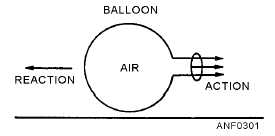CHAPTER 3
PRINCIPLES OF FLIGHT
INTRODUCTION
Man has always wanted to fly. Legends from the
very earliest times bear witness to this wish. Perhaps
the most famous of these legends is the Greek myth
about a father and son who flew with wings made of
wax and feathers. It was not, however, until the
successful flight by the Wright bothers at Kitty Hawk,
North Carolina, that the dream of flying became a
reality. Since the flight at Kitty Hawk, aircraft designers
have spent much time and effort in developing that first
crude flying machine into the modern aircraft of today.
To understand the principles of flight, you must first
become familiar with the physical laws affecting
aerodynamics.
PHYSICAL LAWS AFFECTING
AERODYNAMICS
LEARNING OBJECTIVE:
Identify the
physical laws of aerodynamics to include
Newton's laws of motion and the Bernoulli
principle.
Aerodynamics is the study of the forces that let an
aircraft fly. You should carefully study the principles
covered here. Whether your job is to fly the aircraft
and/or to maintain it, you should know why and how an
aircraft flies. Knowing why and how lets you carry out
your duties more effectively.
LAWS OF MOTION
Motion is the act or process of changing place or
position. Simply put, motion is movement. An object
may be in motion in relation to one object and
motionless in relation to another. For example, a
person sitting in an aircraft flying at 200 mph is at rest
or motionless in relation to the aircraft. However, the
person is in motion in relation to the air or the earth. Air
has no force or power other than pressure when it's
motionless. When air is moving, its force becomes
apparent. A moving object in motionless air has a force
exerted on it as a result of its own motion. It makes no
difference in the effect whether an object is moving in
relation to the air or the air is moving in relation to the
object. The following information explains some basic
laws of motion.
Newton's First Law of Motion
According to Newton's first law of motion (inertia),
an object at rest will remain at rest, or an object in
motion will continue in motion at the same speed and in
the same direction, until an outside force acts on it. For
an aircraft to taxi or fly, a force must be applied to it. It
would remain at rest without an outside force. Once the
aircraft is moving, another force must act on it to bring
it to a stop. It would continue in motion without an
outside force. This willingness of an object to remain at
rest or to continue in motion is referred to as inertia.
Newton's Second Law of Motion
The second law of motion (force) states that if a
object moving with uniform speed is acted upon by an
external force, the change of motion (acceleration) will
be directly proportional to the amount of force and
inversely proportional to the mass of the object being
moved. The motion will take place in the direction in
which the force acts. Simply stated, this means that an
object being pushed by 10 pounds of force will travel
faster than it would if it were pushed by 5 pounds of
force. A heavier object will accelerate more slowly than
a lighter object when an equal force is applied.
Newton's Third Law of Motion
The third law of motion (action and reaction) states
that for every action (force) there is an equal and
opposite reaction (force). This law can be demonstrated
with a balloon. If you inflate a balloon with air and
release it without securing the neck, as the air is
expelled the balloon moves in the opposite direction of
the air rushing out of it. Figure 3-1 shows this law of
motion.
3-1
Figure 3-1.—Newton's third law of motion.

